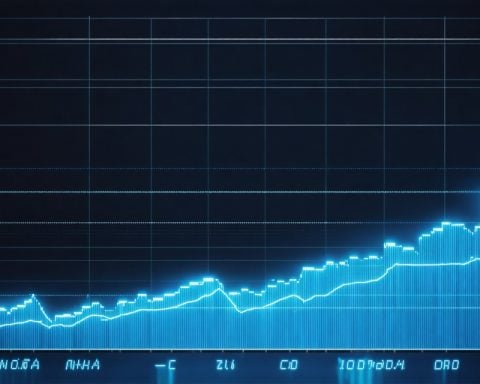- Dividend stocks provide a reliable stream of passive income, adding resilience during market fluctuations.
- Current low yields in the S&P 500 prompt investors to consider dividend-focused companies such as UPS, Brookfield Renewable, and Conagra Brands.
- UPS aims to boost profit margins by targeting lucrative sectors, while enhancing efficiency through strategic automation, offering a 5.6% dividend yield.
- Brookfield Renewable thrives with a solid 5.4% yield, supported by extensive international operations and strong long-term power agreements, making it a stable clean energy choice.
- Conagra Brands focuses on debt reduction and offers value in the packaged food sector, presenting a blend of income potential despite market pressures.
- Strategic investments in dividend stocks can enhance portfolio growth amidst market volatility.
An unassuming charm resides in dividend stocks, often overshadowed by market exhilaration. Yet these financial stalwarts deliver a consistent stream of passive income, infusing resilience into one’s portfolio as market tides shift.
Investors have traditionally relied on index funds for steady returns, yet the current subpar yield of the S&P 500 compels a re-evaluation. Savvy investors eye companies like United Parcel Service (UPS), Brookfield Renewable, and Conagra Brands as attractive investments for dividends.
UPS, the logistics colossus, embarks on a bold strategy to slash low-margin Amazon deliveries by half by 2026. This pivot aims to redirect focus toward more lucrative sectors, such as healthcare and small businesses, promising enhanced profit margins. As UPS builds its “network of the future,” shrewd investments in automation could trim operational slack and amplify efficiency. All these factors underpin a compelling 5.6% dividend yield, turning UPS into a beacon for yield-focused investors.
Meanwhile, Brookfield Renewable stands resilient amid skepticism surrounding renewable energy progression under certain political climates. With vast operations stretching across 20 countries, the company remains unfazed by local policy shifts. Its robust framework of long-term power agreements secures tangible future cash flows, underpinning its enticing dividend yield of 5.4%. For investors yearning for clean energy dividends, Brookfield offers not just potential but stability.
On the corporate horizon, Conagra Brands, despite present pressures, pledges a solid road to debt reduction. As it navigates a tough packaged food market, with its stock at a tempting low, Conagra remains a viable choice for integrating value with income.
The takeaway? In the intricate dance of dividends and market volatility, strategic investments in dividend stocks can bolster wealth—even when market indices showcase their momentary gleam.
Unlocking Dividend Stocks: Why They’re the Secret Weapon in Your Investment Arsenal
How-To Steps & Life Hacks for Investing in Dividend Stocks
Step 1: Identify Stable Companies with Strong Histories
Start by researching companies with a long history of paying dividends, preferably those that increase dividends annually. These are often mature companies with solid financial structures.
Step 2: Analyze Dividend Yields and Payout Ratios
Look for a sustainable dividend yield, typically around 3-6%. Also, analyze the payout ratio, which should ideally be below 60% to ensure the company can sustain payouts even during downturns.
Step 3: Diversify Across Sectors
Spread your investments across different sectors, such as utilities, consumer goods, and technology, to mitigate risks associated with sector-specific downturns.
Step 4: Utilize DRIPs (Dividend Reinvestment Plans)
DRIPs can help automatically reinvest dividends to purchase additional shares, compounding your investment over time.
Real-World Use Cases
– Retirement Income: Dividend stocks can be an effective source of retirement income, providing a steady cash flow without the need to sell underlying assets.
– Educational Funds: For long-term goals like children’s education, consistent dividend payments can build substantial funds over time.
Market Forecasts & Industry Trends
The future of dividend stocks is promising. According to a report by J.P. Morgan, there is a forecasted increase in companies’ ability to maintain dividend payouts due to recovering global economies and steady cash flow generation. Companies in sectors such as renewable energy, like Brookfield Renewable, are expected to gain traction as global investment trends favor sustainability.
Reviews & Comparisons
UPS vs. FedEx: While both are logistics giants, UPS’s strategy to reduce dependency on low-margin sectors like Amazon differentiates it for investors seeking higher yields. UPS boasts stronger dividend returns with its focus on sectors like healthcare.
Brookfield Renewable vs. Enel: Brookfield’s globally diversified assets and long-term contracts contrast with Enel’s more regionally focused operations, making it more appealing for those interested in international exposure to clean energy.
Controversies & Limitations
One limitation is that external economic factors, such as interest rates, can affect dividend stock performance. Additionally, companies may reduce or temporarily halt dividends in response to financial pressure, as seen during the COVID-19 pandemic.
Features, Specs & Pricing
– UPS Dividend Yield: Approximately 5.6%
– Brookfield Renewable Dividend Yield: Approximately 5.4%
– Conagra Brands Dividend Yield: Presenting a comparative value in the packaged goods sector
Security & Sustainability
– UPS: Investing in infrastructure and automation as part of its “network of the future.”
– Brookfield Renewable: Focuses on sustainable energy sources, hedging against policy shifts detrimental to fossil fuels.
Insights & Predictions
Experts predict a robust dividend landscape as companies increasingly prioritize shareholder returns. Sectors like technology could see emerging dividend contenders as companies mature and look to return more cash to investors.
Tutorials & Compatibility
– Online Platforms: Use platforms like E*TRADE or Robinhood for easy access to dividend stocks and automatic enrollment in DRIPs.
– Resources: Access financial news on platforms like Yahoo Finance for up-to-date company analysis and dividend performance.
Pros & Cons Overview
Pros:
– Regular income stream
– Potential for compounding gains via reinvestment
– Potential tax advantages on qualified dividends
Cons:
– Market volatility can affect stock prices
– Dividends are not guaranteed and can be cut
Actionable Recommendations
1. Research Potential Investments: Begin with solid, historically reliable dividend-paying stocks.
2. Utilize Investment Tools: Leverage DRIPs for compounding growth.
3. Regularly Review Your Portfolio: Adjust your holdings annually to align with market trends and personal financial goals.
For more investment tips and financial insights, visit Fidelity and explore opportunities in dividend stocks.
Make informed decisions by understanding the intricate dance of dividends and market volatility to bolster your wealth resilience.



















